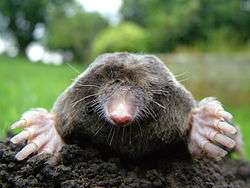土竜
Japanese

Etymology 1
| Kanji in this term | |
|---|---|
| 土 | 竜 |
| Grade: 1 | Grade: S |
| Irregular | |
A surface analysis suggests a derivation from the verb 潜る (moguru, “to go underneath or into something, such as water or the ground”).
However, the modern mogura reading appears to be relatively recent. The older form of this noun was variously ugoromochi, uguromochi, or uguramochi, deriving from now-obsolete verb 墳つ (ugumotsu, uguromotsu, ugomotsu, ugoromotsu, “to become a pile or small hill, as of soil”). This verb itself appears to be a compound deriving from obsolete 穿ぐ (ugu, “to dig a hole”, a 下二段 (shimo nidan) or “lower bigrade” conjugation verb) + 持つ (motsu, “to have in hand; to carry, to bring”), with an underlying idea of “that which digs and brings up the dirt [to form a molehill]”. The verb ugu had a 連体形 (rentaikei, “attributive form”) of uguru, attaching only to nouns, suggesting that the original parsing of this might have been “digging bringer”.
The shift in sound from uguru to the variants uguro and ugoro may be a reflection of the morpheme -ro that appears in numerous words indicating a hollow interior. Compare 空ろ (utsuro, “a hollow, an emptiness”), 室 (muro, “a room; an excavated dwelling on the side of a mountain”), 袋 (fukuro, “a bag”), possibly even 所 (tokoro, “a place”). The ugoromochi reading appears in the 本草和名 (Honzō Wamyō), a pharmacopoeia compiled some time in the years 901–923.
The uguramochi variant was either dialectal, or a later development.
With the beginning of the Edo period and the shift in the political and cultural center to Edo, uguramochi was superseded by the eastern dialectal form muguramochi. The 1603 日葡辞書 (Nippo Jisho, “Japanese-Portuguese Dictionary”) lists one variant as mugura, indicating that the mochi portion could be dropped. This mugura then became mogura, possibly influenced by the verb 潜る (moguru).
Noun
土竜 (shinjitai kanji, kyūjitai kanji 土龍, hiragana もぐら, katakana モグラ, rōmaji mogura)
- a mole (burrowing insectivore)
Usage notes
Given the irregularity of the kanji reading, the もぐら spelling may be more common for this word in general use.
As with many terms that name organisms, this term is often spelled in katakana, especially in biological contexts, as モグラ.
Synonyms
- 田鼠 (denso)
Derived terms
- 金土竜 (kinmogura, “golden mole”)
- 針土竜 (harimogura, “echidna”)
Etymology 2
| Kanji in this term | |
|---|---|
| 土 | 竜 |
| Grade: 1 | Grade: S |
| Irregular | |
Likely a shift in pronunciation from earlier eastern dialectal form muguramochi, possibly influenced by the verb 潜る (moguru).
Pronunciation
Alternative forms
Usage notes
The もぐら reading further above is more common for this word.
Etymology 3
| Kanji in this term | |
|---|---|
| 土 | 竜 |
| Grade: 1 | Grade: S |
| Irregular | |
Shortening of earlier eastern dialectal form muguramochi.
Alternative forms
Usage notes
The もぐら reading further above is more common for this word.
Etymology 4
| Kanji in this term | |
|---|---|
| 土 | 竜 |
| Grade: 1 | Grade: S |
| Irregular | |
Eastern dialectal form of earlier uguramochi reading. Appears in the 日葡辞書 (Nippo Jisho, “Japanese-Portuguese Dictionary”) published in 1603.[1]
Alternative forms
Noun
土竜 (hiragana むぐらもち, rōmaji muguramochi)
- (rare, possibly obsolete) a mole (burrowing insectivore)
Etymology 5
| Kanji in this term | |
|---|---|
| 土 | 竜 |
| Grade: 1 | Grade: S |
| Irregular | |
Older western Japanese dialectal reading. Also appears with this reading in the 日葡辞書 (Nippo Jisho, “Japanese-Portuguese Dictionary”) published in 1603.[1]
Noun
土竜 (hiragana うぐらもち, rōmaji uguramochi)
- (rare, possibly obsolete) a mole (burrowing insectivore)
Etymology 6
| Kanji in this term | |
|---|---|
| 土 | 竜 |
| Grade: 1 | Grade: S |
| Irregular | |
Variant of older western Japanese dialectal reading. Appears with this reading in the 玉葉和歌集 (Gyokuyō Wakashū, “Collection of Jeweled Leaves”) poetry compilation, completed in 1313-1314.[2]
Noun
土竜 (hiragana うぐろもち, rōmaji uguromochi)
- (rare, possibly obsolete) a mole (burrowing insectivore)
Etymology 7
| Kanji in this term | |
|---|---|
| 土 | 竜 |
| Grade: 1 | Grade: S |
| Irregular | |
May be the oldest form. Appears with this reading in the 本草和名 (Honzō Wamyō), a pharmacopoeia compiled some time in the years 901-923.[1]
Derived as the 連用形 (ren'yōkei, “continuative or stem form”) of verb 墳つ (ugumotsu, uguromotsu, ugomotsu, ugoromotsu, “to become a pile or small hill, as of soil”). See above for further details.
Alternative forms
Etymology 8
| Kanji in this term | |
|---|---|
| 土 | 竜 |
| ど Grade: 1 |
りゅう Grade: S |
| on’yomi | |
From 土 (do, “earth”) + 龍 (ryū, “dragon”). Perhaps used erroneously to refer to moles because they dwell underground just like earthworms. Compare Chinese 地龍 (“earthworm”, literally “earth dragon”), English earthworm, worm (“worm; dragon”), wyrm (“dragon; serpent”), Old English wyrm (“worm; serpent”).
Pronunciation
Noun
土竜 (hiragana どりゅう, rōmaji doryū)
References
- 2006, 大辞林 (Daijirin), Third Edition (in Japanese), Tōkyō: Sanseidō, →ISBN
- 1988, 国語大辞典(新装版) (Kokugo Dai Jiten, Revised Edition) (in Japanese), Tōkyō: Shogakukan
- 深根 輔仁 (Fukane Sukehito), editor (901–923) 本草和名 (Honzō Wamyō, Japanese Names of the Real Herbs) (in Japanese), Tōkyō: 紅葉山文庫 (Momiji Yama Bunko, Autumn Leaves Mountain Books), published 1796, OCLC 728064858.
- Doi, Tadao (1603–1604) Hōyaku Nippo Jisho (in Japanese), Tōkyō: Iwanami Shoten, published 1980, →ISBN.